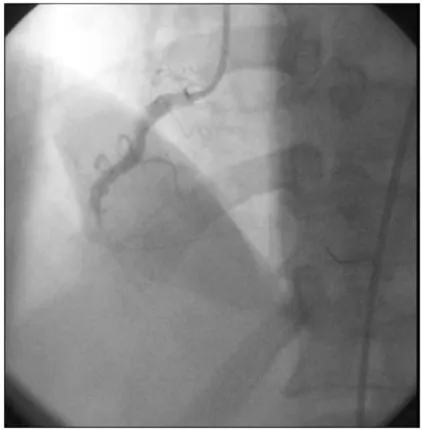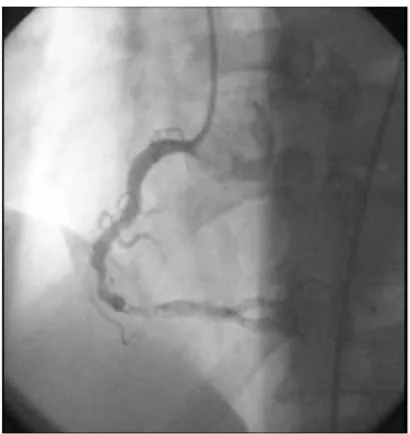Distal embolization durante percutaneous
coronary intervention: a case report
Budi Yuli Setianto1*, Betty Dwi Lestari2
1Department of Cardiology, Faculty of Medicine, Gadjah Mada University/
Dr. Sardjito Hospital Yogyakarta
2Department of Internal Medicine, Faculty of Medicine, Gadjah Mada University/
Dr. Sardjito Hospital Yogyakarta
ABSTRACT
Distal embolization is an acute complication of percutaneous coronary intervention (PCI). Distal embolization of plaque and thrombus material is considered as a major cause of insufficient reperfusion despite a fully patent infarct-related artery, apart from ischemic microvascular damage and reperfusion-induced regional inflammatory responses. In a recent study, angiographic evidence of distal embolization was associated with an 8-fold increase in 5-year mortality. We reported on our experience with distal embolization durante PCI which lead the patient developed ST-Elevation Myocardial Infarct (STEMI) inferior and posterior accompanied with severe chest pain and was treated in the Intesive Coronary Care Unit (ICCU). Distal embolization is the case that we should be put into our awareness because it can worse the after procedural outcome.
Key words: distal embolization-percutaneous coronary intervention-insufficient reperfusion- myocardial ischemia-angiographic
INTRODUCTION
Distal embolization is defined as an abrupt cut-off in the main vessel or one of the coronary branches of the infarct-related artery, distal to the angioplasty site.1Downstream embolization can be
in the form of thrombus and/or plaque contents (atheroma) with vascular obstruction is common after PCI.2 Angiographic evidence of distal
embolization is found in 9% to 15% of the patients after primary PCI for acute myocardial infarction, but the true incidence of distal embolization may be considerably higher, as suggested by autopsy studies and experience with distal protection devices. Distal embolization appears to have major impact on long-term clinical outcome after primary PCI.3
Myocardial ischemia can result from any of the coronary artery complications and can lead to variety of complications either during or after PCI, including chest pain, ST elevation myocardial infact (STEMI), cardiac enzyme elevation, and
myocardial stunning.2We reported on our experience
with distal embolization durante PCI which lead the patient developed STEMI inferior and posterior.
CASE REPORT
A 51 year-old male with diabetes, hypertension and hypercholesterolemia presented with non-ST-elevation myocardial infarction (NSTEMI). His coronary angiogram showed 90% stenosis in mid-and 80% stenosis in distal part of right coronary artery (RCA) and 40% left anterior descendent (LAD) artery (FIGURE 1).
FIGURE 1. 80% and 90% stenosis in RCA FIGURE 2. Predilatation RCA distal
FIGURE 3. Direct stent RCA mid FIGURE 4. Acute clossure
The lesion was dilatated by voyager 30/15 balloon and showed TIMI-2 (Thrombolysis in Myocardial Infarction trial)-2 flow (FIGURE 5). After predilatation, Tsunami Gold 4.0/20 stent was
FIGURE 5. Distal embolization in bifucartion FIGURE 6. Final result TIMI-2 flow after stent deployed
The patient suffered typical chest pain after PCI with the electrocardiogram (ECG) showed STEMI inferior and posterior. The cardiac enzymes were elevated, glutamic oxaloacetic transaminase (GOT) from 24 u/L to 471 u/L, lactate dehydro-genase 1788 u/L, creatine kinase – MB isoform (CK-MB) 237.1 u/L, and troponin I more than 22.78 ng/mL. The patient was treated in ICCU with tirofiban (Aggrastat®) 0.15mcg/kg/hour continued with unfractionated heparin (UFH), acetylsalicylic acid 160 mg twice a day, clopidogrel 75 mg once a day, isosorbide dinitrate 5mg three times a day, atorvastatine 10mg once a day, amlodipine 5mg once a day, fenofibrate 200 mg once a day, ramipril 5mg once a day, and sliding scale to control blood sugar. The third day in ICCU, patient suffered severe chest pain followed with bradycardia. The patient was treated with cervical epidural block combination chirocaine 0.125 mg and morfine 0.125 mg every eight hour. The patient had no chest pain in ninth day and allowed to discharge from hospital.
DISCUSSION
Percutaneous transluminal coronary angioplasty
thrombosis. The availability of intracoronary stents (PCI) and the ongoing improvements in stent design, technique, and antithrombotic therapy have resulted in significant reductions in both of these complications. Acute closure has been reduced from 2 to 10 % with PTCA alone to <1 % in the stent era. The rate of subacute thrombosis has fallen from 5 % with PTCA alone to about 0.5 to 1.0 % with stents. Restenosis rates have fallen from 30 to 40 % after balloon angioplasty to 20 to 30 % after bare metal stents to less than 10 % with drug-eluting stents.4Complications associated with PCI are
similar to those resulting from diagnostic cardiac catheterization, but their prevalence is more frequent. Complications have been categorized as major (death, myocardial infarct (MI), and stroke) or minor (transient ischemic attack, access site complications, renal insufficiency, or adverse reactions to radiographic contrast). Additional specific complications include intracoronary thrombosis, coronary perforation, tamponade, and arrhythmias.5
dysfunction are increased mainly by distal embolization of plaque debris rather than of thrombus.6
Distal embolization can contribute to the “no-reflow” phenomenon after PCI. No-reflow is thought to reflect microvascular dysfunction since there is evidence of myocardial ischemia and reduced antegrade coronary flow in the absence of epicardial stenosis or loss of a distal branch. In a report of patients undergoing PCI for a Non-ST-Elevation Myocardial Infarct (NSTEMI), those with a postprocedural troponin I elevation were significantly more likely to have reduced tissue-level perfusion than those without a troponin I elevation.2
Anatomical (or angiographic) success after PCI is defined as the attainment of residual diameter stenosis less than 50 %, which is generally associated with at least 20 % improvement in diameter stenosis and relief of ischemia. With the widespread use of coronary stent, the angiographic criterion for success is 20 % stenosis or less when stent is used. Procedural success is defined as angiographic success without the occurrence of major complications (death, MI or coronary artery bypass graft (CABG) surgery) within 30 days of the procedure. Clinical success is defined as procedural success without the need for urgent repeat PCI or surgical revascularization within the first 30 days of the procedure.7
Procedural success (TIMI 3 flow) and perfusion (blush score) were reduced with distal embolization and associated with larger infark size, lower ejection fraction, and substantially higher 5-year mortality.8
No-reflow is likely caused by distal embolization of atheromatous and thrombotic debris dislodged by balloon inflation or stent implantation. No-reflow is defined as reduced anterograde perfusion in the absence of flow-limitation stenosis, and occurs in up to 2 to 3 % of PCI procedure.7
The diabetic patients tend to have more distal embolization compare with nondiabetic patients and it is associated with a significantly higher mortality. Review study on 1662 patients undergoing primary angioplasty for STEMI included in 11 randomized trials. Diabetes was observed in a total of 281 patients (16.9%). Diabetic patients were older, with a larger prevalence of female gender, hypertension, hypercholesterolemia, advanced killip class at
presentation and multivessel disease. Diabetes was associated with significant impaired postprocedural TIMI-3 flow, myocardial blush grade (MBG) 2-3, complete ST-segment resolution and more distal embolization. The association with impaired MBG and distal embolization was confirmed after correction for baseline confounding factors. This study showed that, among patients with STEMI undergoing primary angioplasty on the top of glycoprotein IIb-IIIa inhibitors, diabetes mellitus was independently associated with impaired perfusion and distal embolization, that contribute to explain the higher mortality observed in these patients.1
Diabetes is the risk factors for a final TIMI flow grade 2 after primary PCI. The other risk factors are age
70 years, longer time to reperfusion, initial TIMI flow grade d” 1, left ventricular ejection fraction <50 percent.9Patientwho do not achieve TIMI 3 (normal) flow after primary PCI have worse outcomes. The Primary Angioplasty in Myocardial Infarction (PAMI) trials reported patients who had a final TIMI flow grade
2 after PCI had significantly higher rates of in-hospital mortality, and in-in-hospital major adverse cardiac events than those with TIMI 3 flow. At one year, significant differences persisted for mortality, major adverse cardiac events, and reinfarction.9
CONCLUSION
A case of distal embolization durante PCI has been reported. The direct stenting failed and showed acute closure and distal embolization. The patient suffered severe chest pain and the ECG showed ST-elevation MI inferior and posterior. Distal embolization is an acute complication in PCI. We have to be aware of the possibility thrombus and/or plaque debris embolization. Study about distal protection device and intracoronary antithrombotic to prevent distal embolization are stil ongoing.
ACKNOWLEDGMENT
REFERENCES
1. De Luca G, Gibson CM, Bellandi F, Noc M, Dudek D, Zeymer U, Arntz HR, Cutlip D, Maioli M, Zorman S, Mesquita GH, Emre A, Rakowski T, Gyongyosi M, Huber K, Van’t Hof AW. Diabetes mellitus is associated with distal embolization, impaired myocardial perfusion, and higher mortality in patients with ST-segment elevation myocardial infarction treated with primary angioplasty and glycoprotein IIb-IIIa inhibitors. Atherosclerosis 2009; 207: 181-5.
2. Carrozza JP, Cutlip D, Levin T, Williams DO, Saperia GM. Periprocedural complications of percutaneous coronary intervention. [computer program] Up to date 16.3. 2008
3. Gick M, Jander N, Bestehorn HP, Kienzle RP, Ferenc M, Werner K, Comberg T, Peitz K, Zohlnhöfer D, Bassignana V, Buettner HJ, Neumann FJ. Randomized evaluation of the effects of filter-based distal protection on myocardial perfusion and infarct size after primary percutaneous catheter intervention in myocardial infarction with and without ST-segment elevation. Circulation 2005; 112: 1462-9.
4. Cutlip D, Levin T, Williams DO, Saperia GO. General principles of the use of intracoronary stents. [computer program]. Up to date 16.3. 2008
5. ACC/AHA/SCAI. Guideline update for percutaneous coronary intervention: A report of the American College of Cardiology/American Heart Association Task Force on practice guidelines (ACC/AHA/SCAI writing
committee to update the 2001 guidelines for percutaneous coronary intervention). Eur Heart J 2005; 26: 804–47. 6. Mizote I, Ueda Y, Ohtani T, Shimizu M, Takeda Y, Oka T,
Tsujimoto M, Hirayama A, Hori M, Kodama K. Distal protection improved reperfusion and reduced left ventricular dysfunction in patients with acute myocardial infarction who had angioscopically defined ruptured plaque. Circulation 2005; 112:1001-7.
7. Popma JJ, Baim DS, Resnic FS. Percutaneous coronary and valvular intervention. In Braunwald E, Libby P, Bonow RO, Mann DL, Zipes DP. Braunwald’s heart disease. A textbook of cardiovascular medicine. 8thed. Saunders,
Elsevier. 2008; 1419-56.
8. Lane GE, and Holmes DRJr. Primary percutaneous coronary intervention in the management of acute myocardial infarction. In Braunwald E, Libby P, Bonow RO, Mann DL, Zipes DP. Braunwald’s heart disease. A textbook of cardiovascular medicine. 8thed. Saunders,
Elsevier. 2008; 1301-17.
9. Gibson CM, Carrozza JP, Laham RJ, Cutlip D, Saperia GM. Suboptimal reperfusion after primary percutaneous coronary intervention in acute ST elevation myocardial infarction. [computer program]. Up to date 16.3. 2008. 10. Stone GW, Webb J, Cox DA, Brodie BR, Qureshi M,

